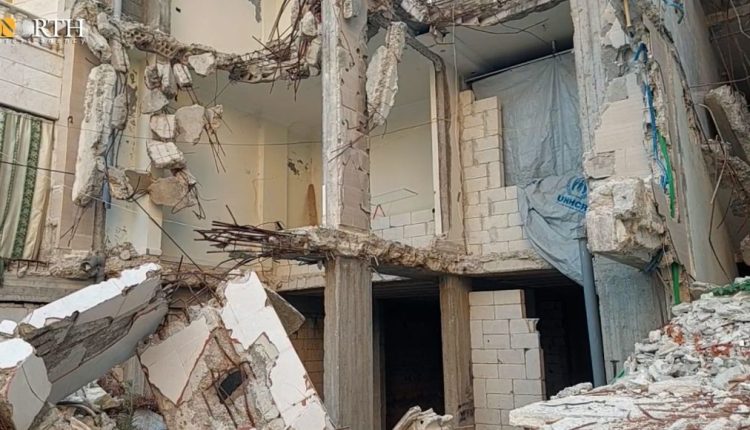
By Safaa Suleiman
LATAKIA, Syria (North Press) – For over 18 months, the Syrian government has continued to issue unfulfilled promises to earthquake victims in Latakia Governorate, western Syria, regarding compensation and relief.
Despite the formation of government committees to assess the damage and provide aid following the devastating earthquake on Feb. 6, 2023, many affected families are still waiting for tangible support.
Although temporary housing projects funded by the United Arab Emirates (UAE) began over a year ago, none of the homes have been delivered to those in need. Thousands of victims remain in dire conditions, either living in unstable buildings or among the rubble of their former homes.
“We just want a place to live in”
Ibrahim, a resident of the city of Jableh, described his family’s daily ordeal in their crumbling building, which is held up by 17 cracked columns.
“Everything is at risk of collapsing,” said Ibrahim. “Fear and panic dominate our lives.”
Latakia and Jableh, following Idlib and Aleppo, are among the areas hardest hit by the earthquake, with over 890,000 people affected.
Ibrahim explained that high rental prices make it impossible for his family to move. “We earn 300,000 SYP, but rent costs over a million. How are we supposed to afford that?”
Despite contacting neighbors to reinforce their damaged building, poverty has left them with no options.
“We just want a place to live. If we leave, we have nowhere else to go.”
Where has the aid gone?
Imad Issa, another resident of Jableh, shared his frustrations. His house was damaged, and though his family made repairs with their own money, they received no substantial government compensation.
“The aid we were promised amounted to nothing more than small food parcels that last just a few days,” he said.
Issa also questioned the fate of the large aid convoys he witnessed entering Syria, saying, “I saw enough aid to last decades—where did it all go?”
According to government media, 108 ships and 138 planes carrying aid have arrived at Latakia’s ports and airport. However, Latakia’s governor, Amer Hilal, stated that only 22,000 families out of the 200,000 affected have received financial assistance—just 5% of those in need.
Each family reportedly received 3.15 million SYP, totaling 70 billion SYP in distributed aid. Yet, Rania, a Jableh resident, like many others, says she has seen none of it.
“The aid was stolen and never reached us,” Rania said, expressing anger. “If you want anything, you either have to humiliate yourself by waiting for hours or know someone on the committee.”
Rania’s husband, a discharged soldier, and their five children have been displaced since their home was destroyed in the earthquake.
Though relatives helped them secure a rental, the rising prices are unsustainable. “Rent is now 500,000 SYP, and my husband can’t pay that.”
Damaged aid and mismanagement
Ali, another Jableh resident, confirmed that most buildings in the area are in desperate need of repairs. Despite visits from government committees, no significant reconstruction efforts have taken place.
“Since the earthquake, we have only received food aid three times,” Youssef, another resident, added, despite the international aid that arrived reportedly being enough for five years.
Moreover, two anonymous sources reported that large quantities of food aid have been damaged due to poor storage conditions, including infestations of rats.
The mismanagement of these resources raises serious concerns about the aid distribution process and the well-being of those it was meant to help.
